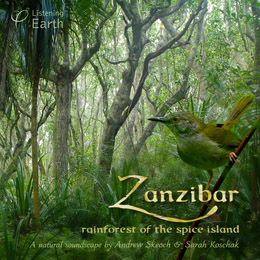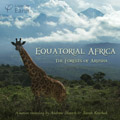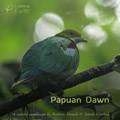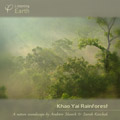

Running Time:
137 min
Release Date:
August 2020
Recording Location:
Jozani Rainforest Reserve, Zanzibar, Tanzania
If you like this album,
we also recommend:
Zanzibar: Rainforest of the Spice Island
The island of Zanzibar lies a short distance off the coast of Tanzania. Considering the island's long history of intensive agriculture, it is surprising that any wild areas remain, but they do. Despite Jozani forest being the largest intact area of primary forest on the island, it is still relatively small, making it all the more precious as a refuge for many rare species. Iconic among them are the endangered red colobus monkeys, found only on Zanzibar.
Entering Jozani forest after dawn, our first impressions are of distant birdsong, a gentle susurration of tree crickets and a sense of peace. The tangle of trees, vines and dense vegetation affords habitat for numerous species, and as we settle into listening more intently, these become evident.
Green-backed camaropteras (our cover species) patrol the undergrowth and attract our attention by being very vocal, continually giving chapping calls and curious zipping contact sounds. Eastern nicators sing back and forth to each other with rich melodies, while greenbulls burble warmly. Two species of tinkerbird create a soft background of steady piping notes, crowned hornbills appear with piercing calls, and forest weavers, attending to their globular nests suspended in the canopy, give the most unusual combination of crystalline whistles and buzzy tones.
Then the colobus monkeys arrive, doing their rounds of the forest and crashing through the foliage overhead, occasionally giving voice with exhilarating calls and wheezy social interactions. As they move on, we note several different species of sunbird as they too move around the forest, while the rich tones of tropical boubous echo through the forest.
Concluding with a final visit from another colobus troop, this spacious recording will take you to an exotic and biodiverse island rainforest off the coast of equatorial Africa.
Andrew comments:
"On first arriving at Jozani, we employed a local guide to meet the endemic red colobus monkeys. This took us into a neighbouring plantation area, where the lower tree heights make them easier to observe as they clamber among the foliage feeding on the abundant fruits.
"From there, we explored the Jozani reserve proper. Walking into the forest along the single foot track felt like entering another world from the surrounding busy villages. Dense, dark, tangled, it seemed a little intimidating at first. But the more we sat quietly, observing butterflies, insects, land crabs and a shy elephant shrew, all while hearing the diversity of rainforest birdsong, we could appreciate how rich and precious this pocket of primary rainforest is.
"After a first morning getting the feel of the place, we decided on a second visit to make further recordings, and this soundscape is an edit of material from the two.
"This visit to Zanzibar began our Tanzanian field trip - our first experience of Africa. It felt exotic then, and listening back now, even though I've subsequently identified many of the species we heard, that sense of mystery remains."
Audio sample of this album
|
1. |
The Rainforest of the Spice Island |
7.46 |
|
2. |
Tree Crickets |
7.23 |
|
3. |
White-browed Coucal and Yellow-rumped Tinkerbird |
3.25 |
|
4. |
Little Greenbull |
4.15 |
|
5. |
Colobus Monkeys Feeding in the Forest Canopy |
4.27 |
|
6. |
Mouse-coloured Sunbird |
1.33 |
|
7. |
Red Colobus Monkey |
3.10 |
|
8. |
Eastern Nicator |
3.02 |
|
9. |
Green-backed Nicator |
3.02 |
|
10. |
Crowned Hornbill |
5.41 |
|
11. |
Camaroptera Contact Calls |
10.51 |
|
12. |
Olive Sunbird |
1.21 |
|
13. |
Jozani Rainforest Chorus |
6.58 |
|
14. |
Camaroptera Song |
5.26 |
|
15. |
The Crowned Hornbill Returns |
2.34 |
|
16. |
Forest Weavers |
6.52 |
|
17. |
Green Tinkerbird |
5.01 |
|
18. |
Black-backed Puffback Chatter |
5.41 |
|
19. |
Tropical Boubou |
10.56 |
|
20. |
Colobus Squeals |
10.36 |
|
21. |
Red Colobus Calls |
1.50 |
|
22. |
Pale Batis |
1.31 |
|
23. |
Scarlet-chested Sunbird |
7.00 |
|
24. |
Forest Weaver Returns |
5.17 |
|
25. |
Tropical Boubou and Yellow-rumped Tinkerbird |
6.10 |
|
26. |
Colobus Social Interactions |
6.07 |
Purchase this
album as:
Digital Album
(for immediate download)
Download this album
for as little as
$7.50 -
View Special Deals
(Prices AU$, exGST)
Mp3:
Mp3 is a universal audio format, playable on iPods, computers, media players and mobile phones.
Mp3 is a compressed format, allowing smaller filesizes, offering faster download times and requiring less storage space on players, but at some expense to the audio quality. Many listeners can't really hear the difference between mp3 and full CD-quality audio, and hence its convenience has lead to it becoming the default option for audio.
Our albums are generally encoded at around 256kbps (sometimes with VBR), balancing optimal audio quality without blowing out filesizes excessively. We encode using the Fraunhoffer algorithm, which preserves more detail in the human audible range than the lame encoder.
Our mp3 files are free of any DRM (digital rights management), so you can transfer them to any of your media technology. You've paid for them, they're yours for your personal use without restriction.
Mp3 files can be burned to disc, either as an mp3 disc, or an audio CD after converting them to a standard audio (.wav or .aif) format first.
FLAC:
FLAC is a high-quality audio format, allowing CD-resolution audio. It is ideal if you wish to burn your files to a CDR, or listen over a high resolution audio system. However files usually require special decoding by the user before playing or burning to disc.
FLAC (Free Lossless Audio Codec) is a LOSSLESS compressed audio format. This means that it preserves the full audio quality of a CD, but optimises the filesize for downloading. Typically, file sizes of around 60% are achieved without any degradation or loss of audio quality from the source files at the CD standard of 16bit/44.1kHz.
Obviously the file sizes are larger than for the mp3 version - usually around 300-400Mb for an album, compared to 100Mb for an mp3 album.
In addition, you'll need to know what to do with the files once you've downloaded them. In most cases you'll want to decode the files to wav or aiff, either to import into programs like iTunes, or burn to CDR. Some programs will play flac files natively.
There is a lot of information about flac online (eg: http://flac.sourceforge.net/)





 Alternate audio link
Alternate audio link 